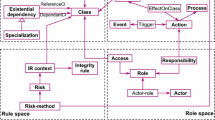Abstract
Recent years have witnessed a tremendous growth in information and communication technologies that facilitate the design and implementation of complex inter-enterprise business processes. One of the major innovations is the concept of service-oriented architectures which considers software systems as being made up with autonomous, dynamic, loosely coupled and service-based components. This paper describes an attempt to automate financial business processes by utilizing a number of basic and composite services. As a case study, the paper describes the implementation of a realistic business process that is related to simulating a trading strategy in capital markets. An evaluation of the appropriateness of service-oriented architectures is conducted taking into account a number of factors such as flexibility, performance and development costs.




Similar content being viewed by others
References
Bolcer G, Kaiser G (1999) SWAP: leveraging the web to manage workflow. IEEE Internet Comput 3(1):55–88
Business Process Management Notation (BPMN). Business process management initiative (BPMI.org), May 2004. Version 1.0, available at http://www.bpmn.org/Documents
Curbera F, Khalaf R, Mukhi N, Tai S, Weerawarana S (2003) The next step in web services. Commun ACM 46(10):29–34
Dabous FT (2005) Pattern-based approach for the architectural design of e-business applications. Phd thesis, School of Information Systems, Technology and Management, The University of New South Wales, Australia
Hammer M, Champy J (1993) Reengineering the corporation: a manifesto for business revolution. HarperBusiness, New York
Harris L (2003) Trading and exchanges: market microstructure for practitioners. Oxford University Press, New York
van den Heuvel W, Papazoglou MP, Jeusfeld MA (1999) Configuring business objects from legacy systems. In: Proceedings of 11th International Conference CAiSE’99. Springer, Heidelberg, Germany, pp 41–56
van den Heuvel W, van Hillegersberg J, Papazoglou M (2002) A methodology to support web-services development using legacy systems. In: IFIP TC8 / WG8.1 Working Conference on Engineering Information Systems in the Internet Context, pp 81–103
Hollinsworth D (1995) The workflow reference model. Technical Report TC00-1003, Workflow Managment Coalition. http://www.wfmc.org/standards/docs/tc003v11.pdf
Homann U, Rill M, Wimmer A (2004) Flexible value structures in banking. Commun ACM 47(5):34–36
Huhns MN, Singh MP (2005) Service-oriented computing: key concepts and principles. Internet Comput IEEE 9(1):75–81
Ma KJ (2005) Web services: what’s real and what’s not? IT Prof 7(2):14–21
Mecella M, Batini C (2000) Cooperation of heterogeneous legacy information systems: a methodological framework. In: Proceedings of the 4th International Enterprise Distributed Object Computing Conference (EDOM’00). Makuhari, Japan, pp 216–225
Mecella M, Pernici B (2001) Designing wrapper components for e-services in integrating hetrogeneous systems. VLDB J 10(1):2–15
Medjahed B, Benatallah B, Bouguettaya A, Ngu AHH, Elmagarmid AK (2003) B2B interactions: issues and enabling technologies. VLDB J:59–85
Papazoglou M (2003) Service-oriented computing: concepts, characteristics and directions. In: Proceedings of the 4th International Conference on Web Information Systems engineering (WISE’03). Rome, Italy, pp 3–12
Pasley J (2005) How BPEL and SOA are changing web services development. Internet Comput IEEE 9(3):60–67
Quocirca Ltd. SOA (2005) Substance or hype—the IT professional verdict on service oriented architecture. Technical report, Quocirca Insight Report, 2005
Rabhi FA, Benatallah B (2002) A service-based architecture for capital markets systems. IEEE Netw 16(1):15–19
Workflow management facility, revised submission, July 1998. ftp://ftp.omg.org/pub/docs/bom/98-06-07.pdf
Yang J, Papazoglou M (2000) Interoperation support for electronic business. Commun ACM 43(6):39–47
Yu H, Rabhi FA, Dabous FT (2004) An exchange service for financial markets. In :Proceedings of the 6th International Conference on Enterprise Information Systems (ICEIS’04). Porto, Portugal, pp 403–410
Zimmermann O, Milinski S, Craes M, Oellermann F (2004) Second generation web services-oriented architecture in production in the finance industry. In: OOPSLA ’04: companion to the 19th annual ACM SIGPLAN conference on Object-oriented programming systems, languages, and applications. ACM Press, New York, pp 283–289
Author information
Authors and Affiliations
Corresponding author
Rights and permissions
About this article
Cite this article
Rabhi, F.A., Yu, H., Dabous, F.T. et al. A service-oriented architecture for financial business processes. ISeB 5, 185–200 (2007). https://doi.org/10.1007/s10257-006-0041-x
Published:
Issue Date:
DOI: https://doi.org/10.1007/s10257-006-0041-x



